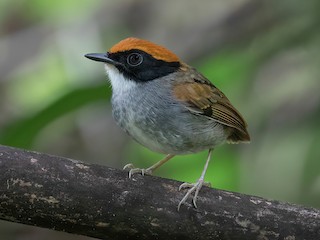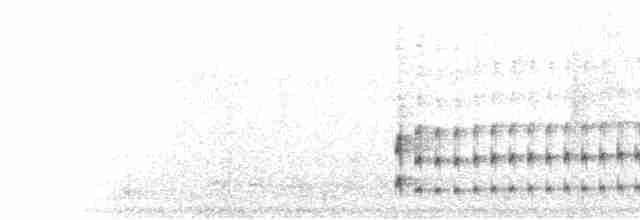Black-cheeked Gnateater Conopophaga melanops Scientific name definitions
Text last updated December 2, 2012
Sign in to see your badges
Species names in all available languages
| Language | Common name |
|---|---|
| Bulgarian | Чернобуза ушата комароловка |
| Catalan | benedictí emmascarat |
| Croatian | crnolici komaraš |
| Czech | mucholovka černolící |
| Danish | Sortkindet Myggesnapper |
| Dutch | Zwartwangmuggeneter |
| English | Black-cheeked Gnateater |
| English (AVI) | Black-cheeked Gnateater |
| English (United States) | Black-cheeked Gnateater |
| Finnish | mustaposkitöpökkä |
| French | Conopophage à joues noires |
| German | Rotscheitel-Mückenfresser |
| Japanese | ホオグロアリサザイ |
| Norwegian | svartkinnmyggeter |
| Polish | mrówkożer maskowy |
| Portuguese (Brazil) | cuspidor-de-máscara-preta |
| Portuguese (Portugal) | Cuspidor-de-máscara-preta |
| Russian | Чернощёкий гусеницеед |
| Serbian | Crnolika mušičarka |
| Slovak | komárožrút čiernolíci |
| Spanish | Jejenero Carinegro |
| Spanish (Spain) | Jejenero carinegro |
| Swedish | svartmaskad knottfågel |
| Turkish | Kara Kulaklı Bityiyen |
| Ukrainian | Гусеницеїд чорнощокий |
Conopophaga melanops (Vieillot, 1818)
Definitions
- CONOPOPHAGA
- melanops
The Key to Scientific Names
Legend Overview
Introduction
Endemic to the Atlantic Forest of eastern Brazil, between Paraíba in the north and Santa Catarina in the south, this species inhabits wet forest and dense, older second growth in the lowlands and foothills, as well as ranging locally into drier forest. The Black-cheeked Gnateater generally forages very low in the undergrowth, sometimes on the ground, and darts rapidly between perches. Males are stunning birds, best detected by their trilling song, with a bright rufous crown, black mask, white throat, gray underparts, and largely brown upperparts, while females are mainly orange-rufous below, with a brownish face, and darker upperparts. Three subspecies have been recognized, but there is substantial individual variation in this species, and it is unclear how many of these might be considered valid.
Identification
10·5–12 cm; three birds averaged 20·1 g. Male has rufous cap with orangish border, black forehead and facial mask, sometimes a few white feathers in postocular region, prominent white throat; upperparts brown, wing-coverts more rufous and sometimes with pale tips; underparts below upper breast grey, flanks tinged orange-buff, belly whitish, extent of grey and white variable; iris dark brown; bill black; legs grey-pink. Female lacks black mask, has grey postocular stripe, orange-rufous underparts with paler throat and belly. Juvenile apparently unknown. Race <em>nigrifrons</em> typically has broader back frontal band, but much individual variation throughout range, and validity of all racial features requires revision (seeFamily Text ).
Systematics History
Editor's Note: This article requires further editing work to merge existing content into the appropriate Subspecies sections. Please bear with us while this update takes place.
Perhaps closest to C. aurita. Races not clearly defined either morphologically or geographically, and taxonomy confused. Contrary to some published statements, black frontal band of male present in all populations; this band perhaps tends to be broader in N than in S, but very variable even at a single locality, and therefore unreliable for any taxonomic diagnosis; variation also in other plumage characters (e.g. presence of spots on wing-coverts or extent of grey or white in underparts) shows no apparent geographical pattern. Race perspicillata may not be diagnosable. Further study needed, especially of long series of specimens, in order to clarify situation. Three subspecies provisionally recognized.Subspecies
Conopophaga melanops nigrifrons Scientific name definitions
Distribution
Conopophaga melanops nigrifrons Pinto, 1954
Definitions
- CONOPOPHAGA
- melanops
- nigrifrons
The Key to Scientific Names
Legend Overview
Conopophaga melanops perspicillata Scientific name definitions
Distribution
Conopophaga melanops perspicillata (Lichtenstein, 1823)
Definitions
- CONOPOPHAGA
- melanops
- perspicillata / perspicillatum / perspicillatus
The Key to Scientific Names
Legend Overview
Conopophaga melanops melanops Scientific name definitions
Distribution
Conopophaga melanops melanops (Vieillot, 1818)
Definitions
- CONOPOPHAGA
- melanops
The Key to Scientific Names
Legend Overview
Distribution
Editor's Note: Additional distribution information for this taxon can be found in the 'Subspecies' article above. In the future we will develop a range-wide distribution article.
General Habitat
Interior and edge of dark, often mossy Atlantic Forest, frequently along streams or in ravines; also dense second growth. Also in drier forest remnants in valley of R Paraiba do Sul, in Rio de Janeiro state. Sea-level to c. 800 m.
Movements and Migration
Sedentary.
Diet and Foraging
Small arthropods. Forages on or near ground; takes items from foliage and leaf litter by making short reaches and by gleaning.
Sounds and Vocal Behavior
Song a tightly spaced trill at 1·5–3·5 kHz, becoming slightly louder as it rises and slows fractionally through final part, the whole lasting c. 5–8 seconds, sound can be approximated by dragging the thumbnail along teeth of a comb; only other vocalization heard regularly is ringing “zhink!” or “zhweenk!”.
Breeding
Oct and Nov in S half of range. Nest in S Bahia was 0·8 m above ground in small tree, another in Paraná 0·6 m above ground and supported by Heliconia stems; 13 nests in Rio de Janeiro were mostly on Dracaena bushes at 20–80 cm above the ground (2). Clutch 2 eggs, beige or buffy with small brownish speckles concentrated in ring around larger end, in Paraná 22·5–22·7 × 17–17·5 mm. Both male and female build nest, incubate and feed nestlings; incubation period, 18 days; nestling period c. 15 days (2). Sitting adults allowe close approach before leaving nest, then performing broken-wing distraction displays on ground, displays becoming more intense during final stages of nestling period. In a study at Rio de Janeiro, Brazil, breeding success 23% (n = 13 nests) (2). At the Paraná nest, both nestlings had been parasitized by flies, possibly of genus Philornis, larger chick harbouring 6 larvae, the other 12.
Conservation Status
Not globally threatened. Generally common. Fairly common to common at Murici Ecological Reserve, in Alagoas, at Una Biological Reserve, in Bahia, at Sooretama Biological Reserve and Linhares Natural Reserve, in Espírito Santo, at Tijuca National Park and the lower elevations of Itatiaia National Park , in Rio de Janeiro; occurs also in several other protected areas. Fairly common also in the Ubatuba region of coastal N São Paulo and the Guaraqueçaba area of Paraná. As other birds of the lowland Atlantic Forest, it has suffered habitat loss on a massive scale; this has been particularly severe in the valley of R Paraíba do Sul, in interior Rio de Janeiro. Tolerates second growth, so long as this fairly dense, and persists at various places even within residential neighbourhoods of Rio de Janeiro.

- Year-round
- Migration
- Breeding
- Non-Breeding

























































